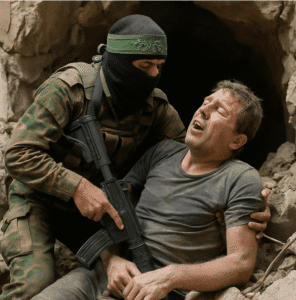Hamas Shocks World: 3-Minute Hostage Rescue Video Exposes Brutal Reality Amid 132 Lives at Risk
Hamas’s Al-Qassam Brigades released gripping footage claiming the rescue of Israeli-American hostage Eidan Alexander from a collapsed Gaza tunnel allegedly bombed by Israel. The video shows militants digging through rubble and administering oxygen to Alexander, heard gasping, “My body hurts… I can’t breathe,” framing Hamas as reluctant caretakers amid Israel’s strikes. Israel dismissed the clip as propaganda, accusing Hamas of exploiting hostages as human shields.
The release escalates pressure on Prime Minister Netanyahu, already embattled by protests demanding a ceasefire and captives’ return, as U.S.-backed truce talks stall. By highlighting Alexander’s ordeal, Hamas seeks to undermine Israel’s military strategy and amplify global criticism of its Gaza campaign. Over 130 hostages remain in Hamas’ custody, their plight weaponized to counter Israel’s claims of operational precision.
Meanwhile, the war’s staggering human toll—38,000 Palestinians killed since 2023—exposes the grim reality of urban warfare and collapsing diplomacy. As families plead for resolution, the video epitomizes a conflict where propaganda and survival collide, leaving civilians trapped in a cycle of despair.

Hamas Shocks World: 3-Minute Hostage Rescue Video Exposes Brutal Reality Amid 132 Lives at Risk
The Al-Qassam Brigades, Hamas’s military wing, unveiled a dramatic video this week purporting to show fighters rescuing an Israeli-American hostage, Eidan Alexander, from a collapsed tunnel in Gaza—a site allegedly bombed by the Israeli military. The footage, released on April 26, 2025, marks a calculated escalation in Hamas’s psychological and propaganda warfare amid stalled ceasefire negotiations and growing domestic pressure on Israeli Prime Minister Benjamin Netanyahu.
The Video: A Narrative of “Rescue”
The 3-minute clip opens with Al-Qassam members digging through rubble in a partially destroyed tunnel, their voices urgent as they call out to Alexander. “Can you hear me? Wait… we’re coming,” a fighter shouts in Hebrew. The scene shifts to fighters hauling Alexander from the debris, his face obscured but audible groans underscoring his distress. “My body hurts… I can’t breathe,” he says before an oxygen mask is placed on him. Al-Qassam claims the rescue occurred after Israeli airstrikes targeted the tunnel days earlier, endangering hostages—a charge Israel denies.
Context: A High-Stakes Blame Game
The video arrives just a week after Hamas announced it lost contact with Alexander, accusing Israel of deliberately striking his holding site. Alexander had previously appeared in a Hamas video, accusing Netanyahu of “trying to kill us all” by rejecting ceasefire terms. His case has become a flashpoint in Israel, where weekly protests demand a deal to free remaining hostages. Meanwhile, Netanyahu’s government insists military operations will continue until Hamas is “dismantled,” despite U.S.-backed proposals for phased truces.
Hamas’s Strategic Calculus
By framing the clip as a “rescue,” Hamas aims to achieve dual objectives:
- Moral High Ground: Portraying themselves as caretakers of hostages—despite international condemnation of their capture—contrasts with Israel’s bombardment, which has killed over 200 hostages since October 2023, according to Hamas.
- Pressure on Netanyahu: Highlighting hostages’ perilous conditions amplifies domestic dissent. Families of captives have intensified protests, accusing the government of prioritizing military objectives over civilian lives.
Israel’s Dilemma
The Israeli military dismissed the video as “psychological warfare,” maintaining that Hamas uses hostages as human shields. Yet the footage complicates Israel’s narrative. While officials argue military pressure forces Hamas to negotiate, critics counter that relentless airstrikes jeopardize hostage survival—a tension Netanyahu’s coalition struggles to balance.
Ceasefire Stalemate and U.S. Role
Recent talks stalled as Israel rejected transitioning to a “phase two” ceasefire, which would require full withdrawal from Gaza. The U.S., under President Donald Trump, backs Israel’s demand for all hostages to be released before any permanent truce—a stance Hamas calls “delusional.” Meanwhile, Al-Qassam’s repeated release of hostage videos (eight since January 2025) seeks to sway global opinion, framing Israel as intransigent.
Broader Implications
The video underscores the evolving battlefield:
- Urban Warfare Challenges: Tunnel systems remain a lifeline for Hamas but double as death traps under bombardment.
- Information Warfare: Hamas’s media strategy exploits Israel’s vulnerability to hostage-related backlash, while Israel leverages allegations of Hamas using civilian infrastructure for attacks.
- Human Cost: With 132 hostages still in Gaza and over 38,000 Palestinians killed since 2023, the cycle of violence deepens humanitarian despair.
Path Forward
As mediators from Egypt and Qatar struggle to revive negotiations, the Al-Qassam video reinforces a grim reality: without a breakthrough, both sides risk further radicalization. For families like Alexander’s, the footage offers fleeting hope but no resolution—a metaphor for a conflict where propaganda and survival are inextricably linked.
You must be logged in to post a comment.